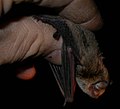Little forest bat
-
The Little Forest Bat is one of Australia's smallest mammals, adults often weighing 4 grams or less.
| Little Forest Bat | |
|---|---|
| Scientific classification | |
| Kingdom: | |
| Phylum: | |
| Class: | |
| Order: | |
| Family: | |
| Genus: | |
| Species: | V. vulturnus
|
| Binomial name | |
| Vespadelus vulturnus (Thomas, 1914)
| |
| Synonyms | |
|
Eptesicus vulturnus Thomas, 1914 | |
The Little Forest Bat (Vespadelus vulturnus) is a species of vesper bat in the Vespertilionidae family.
It is found only in South-eastern Australia including Tasmania. It is a tiny bat often weighing less than 4 grams (males in some areas weigh as little as 2.5 grams)[1]. It is sometimes referred to as Australia's smallest mammal [1][2],although the Northern or Koopmans Pipistrelle Pipistrellus westralis is possibly smaller, weighing on average around 3 grams [2]. It is the smallest bat in Tasmania[3]
Biology and Ecology
The Little Forest Bat is one of the most commonly observed bats in South-eastern Australia, it is found in a variety of habitats including Eucalypt woodlands and forests as well as in rural, semi-rural and some urban areas. It is an insectivore and roosts in tree hollows [3] [4]. Females become sexually mature in their first year and males in their second year. It is assumed the males wake from torpor and mate with the females during winter. A single pup is born in spring (October - November)[5].
Echolocation call
The echolocation call of the Little Forest Bat is regionally variable, in New South Wales the characteristic frequency of search phase calls is between 42.5 and 53 kilohertz depending on the region where it is found.[6][[7]] This is more than double the maximum frequency of the human hearing range and cannot be heard without the assistance of a bat detector.
References
Australian Museum, Bats in Australia[8] van Dyck, S., Strahan, R. (eds)2008. The Mammals of Australia. New Holland. ISBN: 9781877069253
Source
- Chiroptera Specialist Group 1996. Vespadelus vulturnus. 2006 IUCN Red List of Threatened Species. Downloaded on 19 July 2007.


